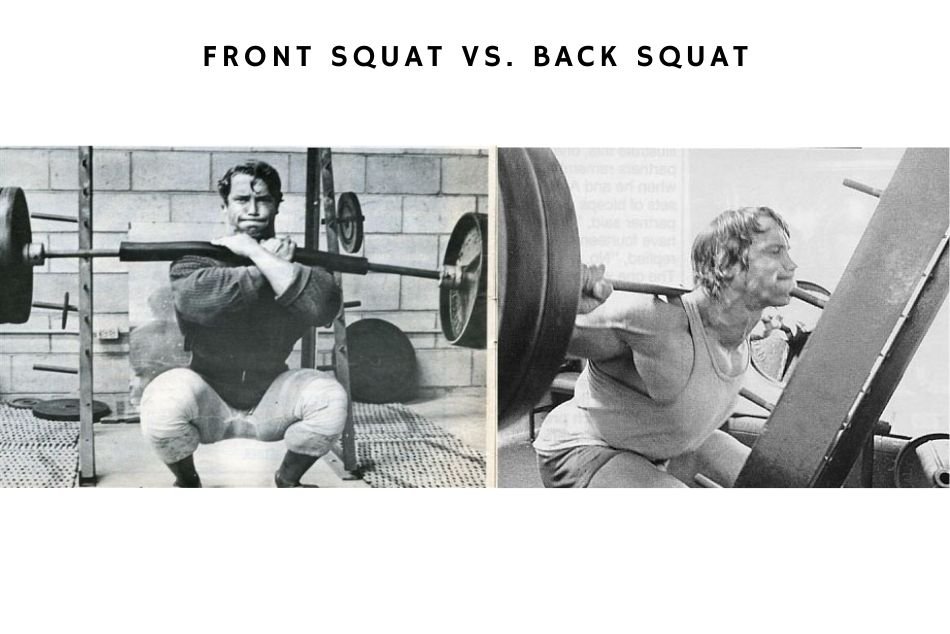Squats Are the King of All Exercise but Should You Do Front or Back Squat
In today’s modern bodybuilding era, most gym-goers are aware of the benefits squat brings, such as squats synthesizing more growth hormone and testosterone or an aesthetically pleasing lower body. Almost everyone agrees that squats rule, and there’s no comparison with other exercises.
But often, people get into the debate of back and front squats. Many are aware of the squats in general but usually discuss differences: front vs. back squat.

How Front Squat Differs From Back Squat?
Put simply, front squats are different from back squats, as both front and back squats work for different muscle groups differently because the placement of the bar changes the motion of the spine, hips, knees & ankles. For instance, fronts squats are more quadriceps and upper back dominant, whereas back squats are more focused towards the lower back, glutes, and hips.
However, if you’re interested in knowing the difference between the two, then continue reading to find the difference between front squat and back squat. So, you can decide on your own whether you should do a front squat instead of the back squat or both.
Front Squat vs. Back Squat – Side by Side Comparison Between the Two
| Front Squats | Back Squats | |
| Major Muscle Recruited | Quadriceps. | Gluteus Maximus. |
| Barbell Positioning | In front squats, you position the barbell onto your shoulders in the front side. | In back squats, you position the barbell across your traps and rear deltoid muscles. That means the weight is on the body’s backside. |
| Praised For | Functional strength benefits. | Foundational movement. |
| Foot Positioning | Your foot should be shoulder-width apart and toes slightly pointed outwards. | Your foot should be slightly outside of your shoulder width while pointing your toes slightly outward. |
| Mobility | Front squats require more mobility. For instance, your upper back (thoracic spine) should be strong enough to keep your chest up. Your wrist should be flexible, mobility of shoulder to rack the bar. Mobility of hip and groin to squat lower, and ankle mobility to prevent rounding of the lower back. | Compared to front squats, back squats require less mobility in hips, ankles, and shoulders. |
| Muscles Worked | In front squats, muscles worked are anterior chain (front body muscles), shoulders, abdominals, upper back, lower back, quadriceps, hamstrings, and glutes. | In back squat muscles worked are the posterior chain (back muscles of your body), upper back, shoulders, abdominals, quadriceps, glutes, hamstrings, and lower back. |
| Hip Extension | Front squats are less helpful for hip muscles compared to back squats. | Back squats give more load on the hips. So, for powerful hip muscles, a back squat is suitable. |
| Strength | Front squats limit your lifting heavier loads, as you’re holding the bar on the front side of your shoulders. | Back squats allow you to lift more weight than front squats as your upper back gives support to lift heavier loads. |
| Shoulder Health | Front squats are more feasible for overhead athletes such as baseball and volleyball players dealing with cranky shoulders. | Back squats may give shoulder irritation to overhead athletes. |
| Common Mistakes | Common mistakes of front squats are like dropping elbows, not sitting into heels, rounding the upper back. | Common mistakes of back squats are like lack of depth, dropping of the chest, and caving of knees or called knees moving forward. |
| Favorable For | Front squats are suitable for aesthetics, quadriceps, and teardrop shape above knees. | Back squats are useful for building raw strength and power. |
| Forced Muscle Activation | Gives greater torque on the knees. | Gives greater torque on the hips. |
| Load | In the front portion of your body, along with anterior deltoids. | Directly on the spine. |
| Lifting Resistance | Low. | High. |
| Main Goal For Athletes | Olympic lifting. | Powerlifting. |
What Is a Front Squat?
The front squat is one variation of squats that’s a lower-body exercise used for strengthening your hips and legs along with quadriceps and glutes. Though a front squat is a squat exercise, unlike back squats, in front squats barbell is placed in front of your shoulders. So, it shifts mass center towards the front side that forces you to keep an upright posture. Thus, it’s a spine-friendly squat exercise.
What Is a Back Squat?
Back squat is one of the fundamental strength exercises used for training your lower body and upper back and abdominal area. Back squats are also mentioned as the king of all exercises because of their ability to build raw power, size, and strength.
Front Squats Form – How to Do Front Squats
For performing front squats, make sure your front squat form is correct and for that, follow the below steps:
- Load the barbell with appropriate weight and lift it from the front side by resting the barbell onto your shoulders.
- Hook your fingers and keep the barbell against your chest with your arms bent, so your hands stay above your elbows, such as you’re holding a goblet using your two hands.
- Keep your foot stance neutral compared to the wider stance.
- Squat down by initiating movement in your hips & bending your knees. And, drop your butt to the floor.
- Make sure your knees are falling outside, and your chest is upward. Avoid falling forward.
- Once your thigh gets parallel or a little below the ground, wait for a moment and push yourself up and get to the standing position. Repeat the reps and complete your set.
Back Squats Form – How to Do Back Squats
For the back squats, go through the below-mentioned steps:
- Get in the starting position, load the barbell on your trapezius muscles (Traps) behind your head.
- Keep your feet shoulder-width apart, chest up, while keeping toes slightly pointing outside..
- Now, start sitting back by bending your knees and dropping your butt towards the floor. Make sure you’re keeping your knees out throughout the rep, and keep your gaze ahead.
- Once your thighs reach parallel or a little below the ground, pause for a moment, push yourself up and get back to standing position and repeat the reps until you complete the set.
Front Squat vs. Back Squat – Benefits of Each
Benefits of Front Squats
Some hidden benefits of front squats are like,
- Through front squats, you can identify weakness in your body—for instance, mobility of your hip, poor strength in quadriceps or glutes muscles.
- Front squats are safe.
- Front squats give better muscle activation.
- Front squats target your quadriceps and glutes muscle in a better way. For example, it offers an extensive range of motion and great depth. The front squats work your quadriceps and glutes muscles differently compared to the traditional back squat.
- Front squats require an upright position, and it helps in strengthening them. Ultimately you get better mobility during back squats.
- Front squats improve mobility of the thoracic region.
- Front squats help improve the athletic performance of CrossFit athletes.
- Front squats help in building core strength.
Back Squat Benefits
It’s not hidden that squat is a good exercise for your lower body. However, if you’re still questioning its benefits, then some of them are:
- Builds stronger glutes.
- Helps in enhancing quadriceps and hamstring muscle strength.
- Builds strength of calf muscles.
- Helps to improve your ability to jump.
- Builds core strength.
- Increases and improves mobility.
- It helps in losing fat.
- Prevents injuries.
- Strengthen your joints.
- Helps to enhance speed and power in the sprint.
- Increases your testosterone and growth hormone.
- Gives a healthy posture.
When You Should Choose Front Squats Instead of Back Squats
- Those who want to improve posture.
- Front squats are suitable for those who feel stress on the spine during back squats because front squats help improve your anterior core engagement, reducing the lower back’s flexion-based injuries.
- For improving your ankle mobility.
- If you’re an overhead athlete, such as involved with volleyball, baseball.
- If you’re an Olympic weightlifter, then front squats are essential.
When You Should Choose Back Squats Instead of Front Squats
- If you’ve just started working out and do not have enough experience in squatting.
- If you’re aspiring or you’re already a powerlifter, then back squats are essential.
- If you’re capable of doing back squats without complaining about back pain.
Front Squats vs. Back Squats – You Should Make Use of Both the Worlds
You can’t say which one is better, front or back squat. So, it’s better to introduce both into your training regimen regularly. However, if you’re an overhead athlete or have a lower-body injury, you should opt to prioritize front squats and not back squats, and it would sound reasonable. But apart from that, there’s no apparent reason why you shouldn’t focus on both in your training session. Specifically, if you’re training lower body twice a week, then you should include both.
Wrapping Up
Both back and front squats are essential in leg workouts, and no one can say that you can skip back squats and do front squats or vice-versa. But, depending upon your fitness level and how good you’re with squats, you can decide whether to incorporate specifically front squats or not. If you’re capable, then it’s recommended that you do both types of squats.
Front and Back Squats – Workout Sample
Here’s a workout sample that you can use if you’re training legs twice a week:
Leg Session 1:
- Leg Extensions – 4 x 20 (Warm-up)
- Front Squats – 5 x 5
- Hack Squats – 4 x 12
- Leg Curls – 5 x 15
- Walking Lunges – 4 x 10
- Seated Calf Raises – 5 x 15
Leg Session 2:
- Back Squats – 5 x 5
- Leg Extensions – 4 x 8
- Split Squats – 4 x 10
- Standing Calf Raises – 5 x 10
- Donkey Calf Raises – 5 x 10
Front Squat vs. Back Squat – FAQs
Which Is Better, Front or Back Squat?
Both front and back squats are beneficial. However, front squats need little more mobility compared to the back squat. So, if you’re a beginner or do not have enough squatting foundation, it’s recommended you start with the back squats and later start transferring towards front squats and also start working on goals. Lastly, if you’re looking for better power and strength, then back squat will benefit you more.
Why Front Squat Seems Harder?
If you don’t have a strong upper back for holding the weight in your front portion, then front squats will be more challenging for you.
Is Front Squat Safe?
Yes, front squats seem safer because forward leaning is less. Though, back squats are also safe towards the lumbar spine if performed with the correct technique and the right amount of weights.
Do Front Squats Hurt the Upper Back?
If someone fails to maintain balance and correct front squats technique, then excessive force gets transferred to the mid-back, and due to that, you can get pain in the upper back portion.
Do Front Squats Improve Posture?
Yes, front squats help improve posture as it forces your body into the thoracic extension that pulls your shoulders back and opens them.
Can You Perform Back and Front Squats on the Same Day?
Yes, you can perform back and front squats both in the same session on the same day. Along with that, you can even add other leg exercises that help stimulate your leg muscles.
Why My Wrist Hurts Whenever I Do Front Squats?
The primary reason for wrist pain during front squats is poor wrist mobility. If you’re using heavyweight and not keeping your elbows in the “up” position before unracking weights, then there’s a high chance of experiencing pain in the wrist.
Are Front Squats Mandatory?
Front squats do full-body movement compared to back squats. If you’re into or interested in Olympic lifting, specifically the clean and jerk, then front squats are among the essential exercise, and they’ll also help build the core and leg strength required to pull big weights.
What’s the Best Alternative of Front Squats?
Hack squats are the best alternative to front squats.





